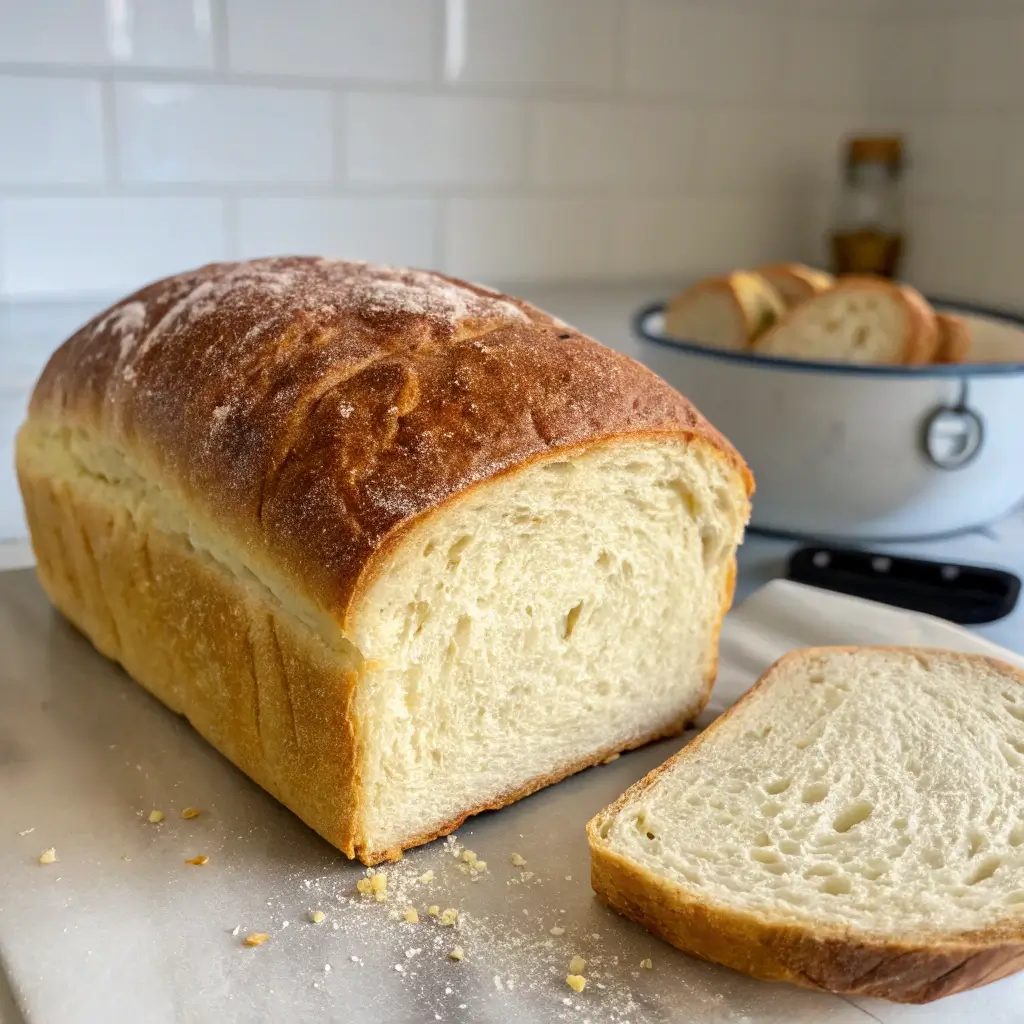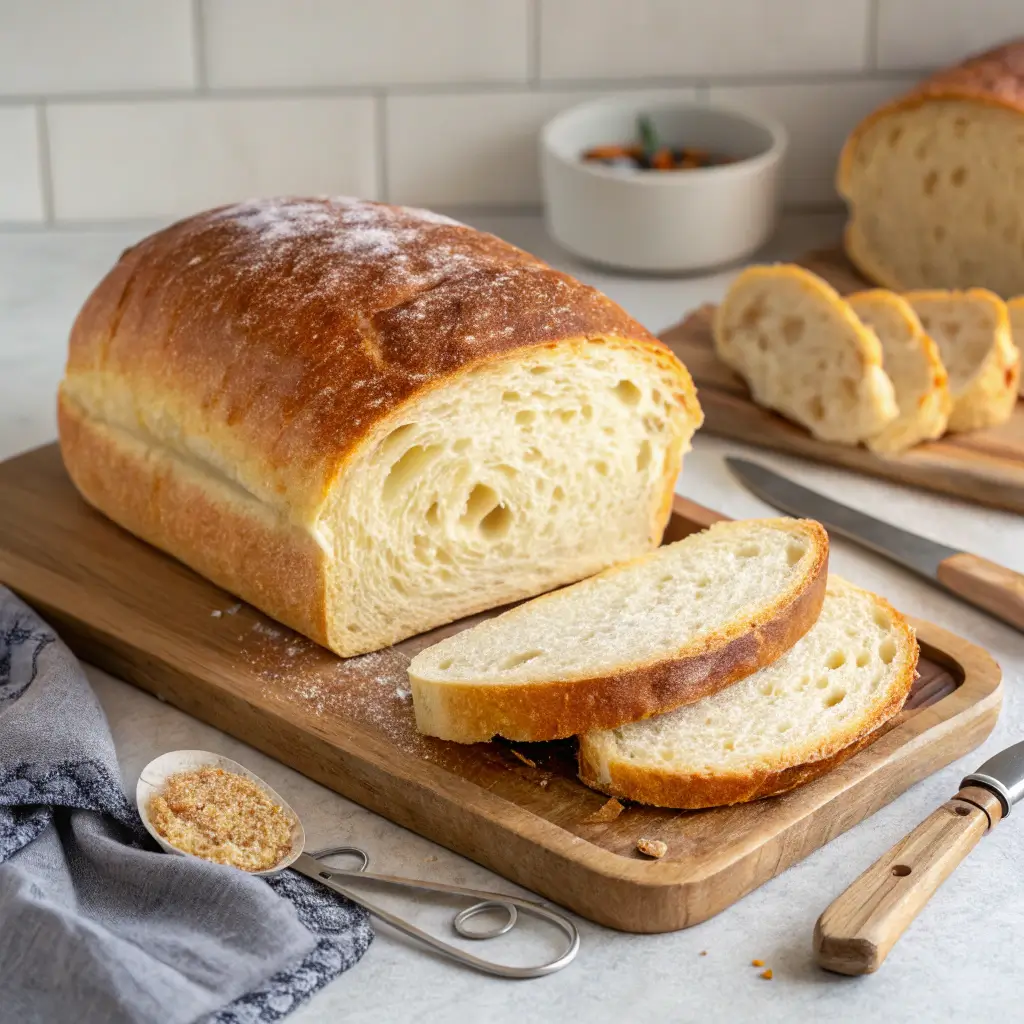If you’re a fan of sourdough but need a loaf that’s softer and ideal for everyday meals, this recipe is your solution. This easy sourdough sandwich bread brings together the naturally leavened flavor you love with the soft texture and structure of classic sandwich bread.
Forget the tough crusts and airy holes of traditional sourdough boules—this loaf is built for slicing, stacking, and toasting. It’s great for sandwiches, morning toast, or even French toast. Best of all, it’s designed for simplicity. There’s no kneading, no shaping stress, and no need for added yeast. The dough rises reliably and bakes into a soft, balanced loaf that fits seamlessly into your weekly routine.
Whether you’re new to sourdough baking or just want a more practical way to enjoy it, this method delivers consistent results with minimal effort.
In this guide, you’ll learn how to make your own sandwich loaf using a sourdough starter, minimal ingredients, and simple tools. We’ll cover everything from starter prep to shaping, baking, storing, and even freezing. If you’ve been intimidated by sourdough in the past, don’t worry—this version is built for home bakers looking for great results without the fuss. with real sourdough flavor? Let’s start with why this style of bread is quickly becoming a favorite.
Table of Contents
Table of Contents
Why Sourdough Sandwich Bread Is the Best of Both Worlds
Sourdough sandwich bread offers the perfect balance between the tangy depth of naturally leavened bread and the soft, structured texture you expect from store-bought sandwich loaves. It’s the ideal choice for those who want to enjoy sourdough’s benefits—like improved digestibility and complex flavor—without giving up the convenience of evenly sliced bread for toast, sandwiches, or meal prep Easy Sourdough Sandwich Bread.
Unlike crusty artisan loaves, which are high-hydration and often baked freestanding, sourdough sandwich bread is designed to be made in a pan. This gives it a taller rise, thinner crust, and a shape that’s perfect for slicing. It’s the same fermentation process, just tweaked for comfort and practicality.
The flavor is where sourdough shines. Thanks to the long, slow rise powered by natural wild yeast, sourdough bread develops subtle layers of sourness and umami that commercial yeasted bread can’t match. That means you’re getting more than great taste—you’re also baking something that’s easier on your gut.
In recent years, this hybrid style of baking has grown in popularity, especially among home bakers looking for more than just crusty artisan loaves. With the right recipe and a bit of planning, you can create a loaf that’s light, moist, and strong enough to hold anything from deli meats to PB&J. And the best part? It’s just as easy to make as other sandwich breads—no fancy tools or baking degrees required Easy Sourdough Sandwich Bread.
What Makes a Sourdough Bread “Easy”?
If you’ve ever been intimidated by sourdough baking, you’re not alone. The long timelines, hydration percentages, and bulk fermentation windows can seem overwhelming—especially for those new to naturally leavened breads. But here’s the good news: easy sourdough sandwich bread skips the stress without sacrificing results.
Fewer Steps, More Success
One of the things that makes a sourdough bread truly “easy” is reducing complexity. Instead of managing multiple stretch-and-folds or complicated shaping techniques, this bread relies on a straightforward mix, bulk ferment, shape, and bake process. You don’t need to perform dough acrobatics to get a light, tender loaf that fits perfectly into a sandwich.
This streamlined method minimizes hands-on time, so you can fit baking into a busy schedule. The dough rests and develops on its own while you go about your day—no need to babysit your bowl every hour.
No Kneading Required
Thanks to the extended fermentation and proper hydration balance, the dough develops gluten on its own. That means you can skip traditional kneading. A few turns with a spatula or your hands during the bulk ferment help build strength, but there’s no need for intensive mixing Easy Sourdough Sandwich Bread.
Predictable Timing
Many sourdough recipes can be unpredictable depending on your kitchen temperature or starter strength. But this easy version is built for flexibility. You can choose to bulk ferment at room temperature or refrigerate the dough overnight for better flavor and schedule control. With clear rise markers and simple cues, this loaf removes the guesswork Easy Sourdough Sandwich Bread.
Consistent Results with a Loaf Pan
Using a loaf pan helps the dough rise upward instead of spreading out, which means even if your shaping isn’t perfect, your bread still turns out tall and beautiful. The loaf pan also produces a thinner crust that’s easier to slice—just what you want in sandwich bread. Unlike artisan boules that demand perfect tension and scoring, this method is more forgiving and delivers consistent, sliceable results Easy Sourdough Sandwich Bread.
Adaptable to Your Life
It works on your timeline. Mix in the evening, bake the next day. Whether you’re meal prepping for the week or just want a better bread for your BLT, this recipe adapts to your routine.
By stripping away the complications—but keeping the soul of sourdough intact—this method lets you enjoy homemade, naturally leavened sandwich bread without the intimidation factor Easy Sourdough Sandwich Bread.
Choosing the Right Starter for Sourdough Sandwich Bread
Your sourdough starter is the backbone of your bread—it’s the living culture that makes the dough rise, gives the loaf its distinctive tang, and contributes to its final texture. But when you’re making easy sourdough sandwich bread, the type and condition of your starter matters more than you might think. Choosing the right one, and knowing when it’s ready, can mean the difference between a soft, lofty loaf and a dense disappointment Easy Sourdough Sandwich Bread.

Active vs. Fed Starter: What You Really Need
There’s a lot of confusion around terms like “fed,” “active,” and “mature.” For sandwich-style sourdough, you want your starter at peak activity—bubbly, airy, and slightly domed. This usually means feeding your starter about 4–6 hours before mixing your dough, depending on room temperature Easy Sourdough Sandwich Bread .
An active sourdough starter ensures your dough will rise well without adding commercial yeast. Since sandwich bread needs to be soft and airy inside, using a sluggish starter will slow fermentation and limit your loaf’s height and texture.
Mild or Tangy? Flavor Control Starts with the Starter
Unlike rustic sourdough loaves, where a sharp tang is often desirable, sourdough sandwich bread is typically milder in flavor. If you prefer a softer sour profile (which pairs better with sweet or savory toppings), you’ll want to feed your starter more frequently and use it earlier in its fermentation cycle. This prevents it from becoming too acidic Easy Sourdough Sandwich Bread.
On the other hand, if you like a touch more sourness in your sandwich loaf, you can let your starter ferment longer before using it. A slightly overripe starter will create deeper flavor, though it may ferment the dough a bit faster—so watch rise times closely Easy Sourdough Sandwich Bread .
Whole Wheat Starters vs. White Flour Starters
You can make sandwich bread with either type of starter, but keep in mind that white flour starters tend to produce a softer crumb and milder flavor, which suits sandwich bread perfectly. Whole wheat or rye starters are more active and flavorful, but they can sometimes result in denser loaves if the flour blend isn’t balanced carefully.
If you’re working with a whole wheat starter, consider using mostly bread flour in the final dough to preserve lightness while still keeping the depth of flavorEasy Sourdough Sandwich Bread.
How to Know When It’s Ready to Use
- Has doubled in size within 4–6 hours after feeding
- Looks bubbly and slightly domed on top
- Passes the “float test” (a teaspoon floats in water)
- Smells tangy, not sour or alcoholic
Using your starter at the right time gives you the best fermentation power and the softest, most dependable rise—exactly what you want in sandwich bread.
Ingredients and Equipment You’ll Need
What sets this recipe apart is its simplicity. With just a few high-quality ingredients and a couple of dependable tools, you can create a loaf that’s flavorful, soft, and worthy of becoming your go-to bread for sandwiches, toast, and everything in between.
Key Ingredients for a Soft and Flavorful Loaf
The ingredient list is short, but each item matters. The following essentials are what give sourdough sandwich bread its signature texture and taste:Easy Sourdough Sandwich Bread
Bread Flour:
High-protein bread flour gives your dough the strength it needs for a tall rise and tender chew. All-purpose flour can work, but bread flour consistently delivers a better crumb for sandwich-style loaves.
Sourdough Starter:
An active, bubbly starter is the core of your dough. Whether you use a white or whole wheat starter, make sure it’s recently fed and at its peak.
Water:
Filtered or dechlorinated water is ideal for supporting fermentation. Chlorine can interfere with your starter’s live cultures, so avoid using straight tap water if possible.
Salt:
Fine sea salt helps enhance the flavor and structure. It also regulates fermentation speed, keeping your dough balanced.
Optional: A Touch of Honey or Oil
To soften the crumb and extend shelf life, you can add a small amount of honey, maple syrup, or olive oil.
Equipment to Make the Process Smoother
Even though the method is simple, the right tools make baking easier and more consistent. Here’s what you’ll want on hand:
Loaf Pan (8.5″ x 4.5″ or 9″ x 5″)
A standard metal loaf pan shapes the dough and ensures even rise.
Digital Kitchen Scale
Precision matters in sourdough baking. Measuring flour and water by weight instead of volume gives more reliable results, especially for hydration levels.
Mixing Bowl and Spatula
A flexible spatula or dough scraper helps fold and shape the dough without sticking.
Proofing Container or See-Through Tub
For bulk fermentation, a clear container lets you track dough rise easily. Marking the initial level helps you know when it’s doubled.
Kitchen Thermometer (Optional)
If you want to be exact, monitoring the dough’s temperature can help with fermentation timing, especially in cooler kitchens.
Plastic Wrap or Damp Towel
You’ll need to cover the dough during proofing to keep it from drying out.
Parchment Paper and Cooling Rack
Parchment makes transferring and releasing the dough from the pan easier, and a cooling rack prevents soggy bottoms after baking.
With just these ingredients and tools, you’re fully equipped to bake a loaf of easy sourdough sandwich bread that’s soft, tangy, and perfect for everyday meals. In the next section, we’ll walk through the s
Step-by-Step Easy Sourdough Sandwich Bread Recipe
Ready to bake? Whether you’re new to sourdough or just want a loaf that fits your daily routine, this method will guide you through each step with clarity and confidence Easy Sourdough Sandwich Bread.
This recipe yields one soft, sliceable loaf perfect for sandwiches, toast, or snacking Easy Sourdough Sandwich Bread.

Ingredients
- 450g bread flour
- 100g active sourdough starter (fed and bubbly)
- 280g water (room temperature)
- 9g fine sea salt
- Optional: 15g honey or olive oil for added softness
Step 1 : Stretch and Fold Easy Sourdough Sandwich Bread
After resting, perform one round of stretch and folds: grab a section of dough, stretch it upward, then fold it over. Repeat on all four sides of the bowl. This helps strengthen the dough without kneading.
Let the dough rest, covered, at room temperature for 4–6 hours. It should rise by about 50–75% and become smoother. Perform one or two additional stretch-and-folds during this bulk fermentation, spaced 45–60 minutes apart, if desired.
Step 2 : Shape and Pan
Gently shape it into a rectangle, then roll it up tightly like a jelly roll. Pinch the seam and ends closed.
Step 4: Final Proof
This may take 2–4 hours at room temperature, depending on the temperature and starter strength.
Alternatively, cover and refrigerate the loaf overnight (up to 12 hours). This cold proof enhances flavor and structure.
Step 5: Bake
Preheat your oven to 375°F (190°C). If using a refrigerated dough, let it sit at room temperature for 30 minutes while the oven heats.
Step 6: Cool and Slice
Remove the bread from the pan and let it cool completely on a wire rack—at least 1 hour. This step is crucial for setting the crumb.
Baker’s Notes:
- For a softer crust, brush the top with butter immediately after baking.
- Store cooled bread in a reusable bread bag or airtight container for up to 4 days.
This easy sourdough sandwich bread recipe proves you don’t need complicated steps or fancy tools to bake incredible bread. It’s flexible, forgiving, and fits into a real-life schedule without sacrificing flavor or texture.
How to Get a Soft Crumb and Tender Crust
When you think of sourdough bread, you might imagine a chewy, open crumb with a thick, crackling crust—but that’s not what you want in a sandwich loaf. Instead, easy sourdough sandwich bread should be soft, fluffy, and easy to slice without tearing. It should hold your favorite fillings without falling apart and toast to perfection without turning brittle.
Hydration: The Right Balance for a Tender Crumb
One of the first keys to getting a soft, even crumb is managing hydration correctly. While artisan loaves often use 75%+ hydration, sandwich bread benefits from a slightly lower range—typically between 60–65% hydration.
It also keeps the crumb soft and sturdy—perfect for toast, grilled cheese, or peanut butter sandwiches.
Fermentation: Don’t Overdo It
Over-proofing is a common cause of tough or overly sour sandwich bread. For this style of loaf, you’re not chasing a strong tang—you’re aiming for mild sourdough flavor with a soft bite. That means shorter fermentation times or cooler proofing environments to slow things down.
Avoid letting the final rise go too long. Once your dough has risen just above the rim of the loaf pan and springs back slightly when touched, it’s ready. Over-proofed dough will collapse or bake with a gummy, compressed crumb.
Stick to the guidelines: 4–6 hours bulk ferment, 2–4 hours final proof (or overnight cold proof). Trust the look and feel more than the clock.
Baking Techniques for a Softer Crust
Instead of the high-heat blast used in artisan baking, sandwich sourdough loaves do better at moderate temperatures around 375°F (190°C). This helps the crust bake thin and golden without becoming hard or chewy.
If you want an even softer crust:
- Tent the loaf with foil in the last 15 minutes of baking to prevent over-browning.
- Brush the top with melted butter immediately after baking to soften the outer layer and add a subtle richness.
Shaping for Structure
The loaf pan guides the rise upward, while the shaping helps prevent weak spots or tunnels.
With the right hydration level, a gentle fermentation schedule, and a moderate bake, your easy sourdough sandwich bread will come out just right—soft, sliceable, and satisfying every time

Storing, Slicing, and Freezing Your Loaf
You’ve baked the perfect easy sourdough sandwich bread—golden on the outside, soft on the inside, and full of natural flavor. Now what? How you store and slice your loaf is just as important as how you bake it. Done right, your bread will stay soft for days, freeze beautifully, and provide clean, even slices for everything from school lunches to morning toast.
How to Store Sourdough Sandwich Bread for Maximum Freshness
Unlike store-bought bread loaded with preservatives, homemade sourdough needs a little more care. But with the right steps, you can keep it fresh and soft without drying it out Easy Sourdough Sandwich Bread.
- Room Temperature (Short-Term):
Store your fully cooled loaf in a breathable container like a cloth bread bag or beeswax wrap. This preserves the soft crust and prevents condensation. If your kitchen is humid, a paper bag inside a bread box also works well. - Airtight Plastic (1–3 Days):
For extra moisture retention, wrap your loaf in plastic wrap or place it in a resealable bag once it’s fully cooled. This works best if you plan to finish the loaf within 2–3 days. - Avoid the Fridge:
Never refrigerate sourdough bread—it speeds up staling. The fridge environment causes the starches to retrograde more quickly, making the crumb hard and dry.
Tips for Slicing Without Crushing the Crumb
Getting clean, even slices is essential for sandwich bread. A poorly cut loaf can tear or compress the crumb, especially if it’s still warm Easy Sourdough Sandwich Bread .
- Always cool completely. Cutting into warm sourdough will lead to gummy slices. Wait at least 1 hour after baking.
- Use a long, serrated bread knife. Gentle sawing motions work better than pressure. Let the knife do the work.
- For thinner slices, turn the loaf on its side—this gives you a flatter surface and more control.
Reheating Suggestions
To revive that just-baked softness, reheat your slice in a toaster or wrap the loaf in foil and warm in the oven at 300°F for 10–15 minutes. A quick steam under a damp paper towel in the microwave (10 seconds max) can also freshen up slices.
With smart storage and slicing, your easy sourdough sandwich bread can go from fresh-baked to freezer and back to fresh-tasting with no loss of texture or flavor. Whether you bake once a week or once a month, these tips help keep every loaf soft, usable, and satisfying.
Delicious Ways to Use Your Sourdough Sandwich Bread
Now that your easy sourdough sandwich bread is baked, stored, and sliced, let’s talk about the fun part—eating it. This type of bread is more than just a basic loaf. With its soft crumb, mild tang, and sturdy structure, it’s the perfect foundation for a variety of meals, snacks, and creative culinary ideas.
Whether you’re feeding picky kids, prepping work lunches, or just elevating your breakfast, this sourdough loaf can do it all. Here are our favorite ways to use it.
Classic Sandwiches (and Upgrades)
- Grilled Cheese:
Mild sourdough makes the perfect vehicle for gooey melted cheddar or mozzarella. Add tomato, pesto, or caramelized onions for a gourmet twist. - Turkey & Avocado Club:
Stack slices of roast turkey, crispy bacon, fresh avocado, and lettuce between two slices of your sourdough sandwich bread. Add a smear of mayo or mustard for the classic deli vibe. - PB&J with a Twist:
Sourdough’s gentle tang brings new life to peanut butter and jam. Try it toasted for a warm, crispy variation that kids and adults both love. - Egg Salad or Tuna Salad:
Because of its structure, sourdough sandwich bread holds up to moisture-heavy fillings without going soggy. Add fresh lettuce for crunch Easy Sourdough Sandwich Bread.
Breakfast and Brunch Favorites
- French Toast:
Thick slices of slightly stale sourdough make phenomenal French toast. The bread soaks up egg custard beautifully while still holding its shape. - Avocado Toast:
Toast slices and top with smashed avocado, sea salt, red pepper flakes, or a poached egg. The sourdough flavor elevates even the simplest toppings. - Toasted with Jam and Butter:
Sometimes the simplest uses are the best. A warm slice of toasted sourdough sandwich bread with salted butter and berry jam hits the spot every time.
Meal Prep & Kid-Friendly Options
- Open-Faced Tartines:
Top toasted slices with hummus, roasted vegetables, or smoked salmon and cream cheese for quick, nutritious lunches or light dinners. - Croutons or Breadcrumbs:
Use leftover slices to make homemade croutons or breadcrumbs. Cube and bake with olive oil and herbs, or pulse in a food processor for breading Easy Sourdough Sandwich Bread.
Toast Ideas That Go Beyond Basic
| Toast Idea | Toppings |
|---|---|
| Savory Sourdough Toast | Ricotta, cherry tomatoes, basil, balsamic drizzle |
| Sweet Morning Toast | Almond butter, banana, cinnamon |
| Protein Boost | Cottage cheese, smoked turkey, microgreens |
| Spicy Avocado Smash | Avocado, chili flakes, sesame seeds, lemon juice |
From savory stacks to sweet spreads, your easy sourdough sandwich bread works for every meal of the day. Its mild flavor and soft texture make it endlessly versatile and even more rewarding to bake when you realize just how many ways you can enjoy it.
Common Mistakes and How to Fix Them
Even with a simple recipe, baking easy sourdough sandwich bread can sometimes go sideways—especially if you’re new to sourdough. But don’t worry. The most common issues are easy to identify and fix with just a few tweaks.
Here are the top mistakes beginners make—and how to solve them before your loaf flops Easy Sourdough Sandwich Bread.
Mistake #1: Dough Too Sticky or Too Dry
The problem: Your dough is hard to handle, sticks to everything, or feels stiff and unworkable..
Remember, temperature affects hydration too—flour absorbs water differently in humid vs. dry conditions.
Mistake #2: Bread Doesn’t Rise Enough
The problem: Your loaf turns out flat, dense, or compact, even after proofing.
The fix: It’s usually due to an underperforming starter. Make sure your sourdough starter is active, bubbly, and fed 4–6 hours before use. Also check room temperature—cool environments slow fermentation. Try extending your proofing time or placing the dough somewhere warmer (ideally 72–78°F) Easy Sourdough Sandwich Bread.
Using too much whole wheat flour or over-handling the dough can also reduce rise Easy Sourdough Sandwich Bread.
Mistake #3: Overproofing the Dough
The problem: Your dough rose beautifully… then collapsed or baked into a gummy mess.
The fix: Watch the dough, not the clock. Your dough is ready for baking when it has risen just above the pan’s rim and springs back slightly when pressed. If the dough over-ferments, structure breaks down, and the loaf can collapse or lose oven spring.
Use a finger dent test—if the dough doesn’t bounce back at all, it’s likely overproofed.
Mistake #4: Sourdough Flavor Too Strong
The problem: The tang is overpowering, especially for sandwiches or kids.
The fix: Use your starter earlier in its peak activity (younger starter = milder flavor). Also, reduce fermentation time slightly, and avoid long, warm proofs. If you like less sourness, refrigerate dough for a shorter time (or skip cold ferment altogether).
Adding a small amount of honey to the dough can also balance the acidity naturally.
Mistake #5: Crumb is Dense or Gummy
The problem: The bread looks baked on the outside but is gummy, undercooked, or heavy inside.
The fix: This usually happens when the loaf isn’t fully baked or is sliced too soon. Use a thermometer to ensure the internal temperature hits 195–200°F before removing it from the oven. Always cool the loaf completely on a wire rack before slicing. Cutting too early traps steam, making the crumb gummy.
Bonus Tip: Keep Notes
Sourdough baking improves quickly when you write down what works—and what doesn’t. Keep a baking log with: Easy Sourdough Sandwich Bread
- Room temperature
- Fermentation times
- Hydration percentages
- Starter condition
- Final loaf results
That way, you can fine-tune your process and dial in your easy sourdough sandwich bread to perfection.
visit our page facebook Easy Sourdough Sandwich Bread









